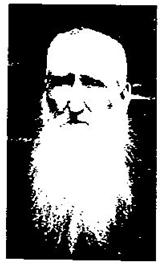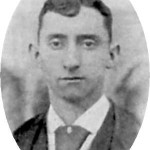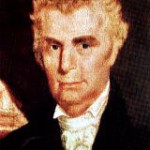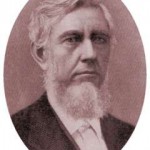He was converted to the ancient faith by Restoration legends Barton Stone and Benjamin Franklin (the preacher, not the Founding Father). He was a crusty old-timer known for “always calling a spade a spade,” yet he was equally notable for his forgiving, sacrificing spirit. In those days when pulpits were “aflame with righteousness,” he kept the Ozark Mountains echoing with the Word of God. He was my ancestor, and his tale holds a lesson for all.
“But I say to you who hear, ‘Love your enemies, do good to those who hate you, bless those who curse you, pray for those who mistreat you. Whoever hits you on the cheek, offer him the other also; and whoever takes away your coat, do not withhold your shirt from him either.’”
—The words of Jesus, as recorded in Luke 6:27-29
I have long thought that there was something more to Jesus’ advice to “turn the other cheek” than just the ideas of self-restraint and good will toward men.
I have come to believe that when Jesus told his followers to “turn the other cheek,” He was saying something calculated as much to help them as to constrain them. To show how He was trying to help, I must resort to an anecdote from my family’s history.

In his 1967 book Arkansas Angels, minister Boyd E. Morgan related the life stories of scores of preachers who labored for the cause of Christ in the northeastern sector of the state of Arkansas in the 1800s and early 1900s. The farthest-back pioneer of whom Morgan could find any record was a preacher by the name of John M. Lemmons. This man was my great, great, great grandfather. Morgan related his story thus:
“Brother John M. Lemmons… was born in Virginia in 1816. He moved with his parents to Warren County, Tenn., in 1818. He married and lived in Warren County until 1851, when he moved to Arkansas, locating first in Independence County. After one year, he moved to Randolph County.
“John M. was a preacher of the Church of Christ. I know nothing of his conversion or when he first began preaching, except that for more than 40 years he preached the gospel of Christ. He died in 1898 at the age of 82.
“In the same year he moved to Randolph County, he and his oldest sons (he was the father of seven sons and two daughters) and two or three neighbors built a log church building on Hubble Creek, one mile south of Birdell, Ark.… Brother Lemmons did much to help establish the church in North Arkansas. He served as an elder as well as a preacher.
“Two of his sons, Peyton and Josephus, were preachers of great ability, and were among the leading preachers of the Churches of Christ of North Arkansas and South Missouri. There have been a number of ministers in each generation… of descendants of John M. Lemmons. Brethren Reuel Lemmons and A.G. Lemmons are direct descendants of this grand pioneer preacher.”
[Editor’s note: The remainder of this material includes several family names. If things get a little hard to follow, refer back to this family-tree backgrounder: John M. Lemmons’ son Josephus was father of (among other children) Walter Edgar Lemmons and Benjamin Monroe Lemmons. Walter Edgar became father of Reuel Lemmons, who is mentioned below. John M.’s son Peyton, meanwhile, was the father of W.F. Lemmons, who is mentioned below. Benjamin Monroe Lemmons was the great-grandfather of the editor.]

In his bio of John M. Lemmons, Morgan cited a 1930 magazine article in the Gospel Advocate, penned by (evangelist) W.F. Lemmons (grandson of John M. Lemmons) on the occasion of the death of yet another Arkansas church leader, W.H. Tomlinson (1844-1930). In that article, W.F. Lemmons remarked that “if memory served [him] correctly,” it was his grandfather, John M. Lemmons, who baptized W.H. Tomlinson. The baptism took place in the early 1860s (Civil War era). More to the point, the younger Lemmons recalled that Tomlinson was witness to another baptism by John M. Lemmons, an occasion when a man shot at Lemmons as the preacher was baptizing the man’s wife.
W.F. Lemmons added: “It is a fact that he (John M.) later baptized the man who shot at him.”
Tomlinson, incidentally, was a man known for his “plainness of speech” (read: direct and to-the-point), a trait he was said to have picked up from old John M., someone who “always called a spade a spade.”
A Different Kind of “Payback”
Why did the man shoot at the preacher? “These were pioneer days in Northeast Arkansas,” W.F. Lemmons wrote. “Sectarianism had blood in its eyes, as it were, and to preach the primitive gospel was the sin against the Holy Ghost with the sects.” [In calling something “the sin against the Holy Ghost,” Lemmons was saying it was “the unforgiveable sin.” Where he refers to “the sects,” he refers to other, dissenting bodies of believers—most notably those who did not agree with the doctrine of baptism-by-immersion. His reference to the “primitive gospel” was his way of connecting baptism-by-immersion with the practices of 1st century (early-day, hence “primitive”) Christians. – JFM]
Yet more light was cast upon the shooting/baptizing incidents when Reuel Lemmons, great-grandson to the old patriarch, provided additional details in a 1987 letter to a fellow church member.

In the letter, Reuel had this to say about the 1930 article and its author:
“W.F. (Will) Lemmons was a 2nd cousin of mine. His relating of the shooting incident at the baptism is accurate. Let me add another note to the story. Following the baptism, one of John Lemmons’ hogs got out of the pen and the man shot the hog. My great-grandfather dressed the hog and took half of it over to the man’s house and gave it to him. That act did eventually result in the man’s conversion.”
As indicated at the outset of this discussion, Boyd Morgan knew “nothing of his [John M.’s] conversion,” but another source I found [Albert Lemmons, a descendant of the old preacher] has written, no doubt with family knowledge, that John M. was converted by the prominent Restoration preachers

Barton W. Stone and Benjamin Franklin (not the Ben Franklin who was a Founding Father, but rather the mid-late-19th century preacher Benjamin Franklin [1812-1898]).
Find Franklin’s Wikipedia entry here. Find Stone’s Wikipedia entry here.
My mother was a second cousin to Reuel Lemmons. Reuel passed away in 1989.

It was Reuel who, of the numerous and notable preachers who came from this family, received the most acclaim, both as evangelist and as author/editor. For a brief biography, click here.
John M. Lemmons’ actions demonstrate a principle that undergirds Jesus’ message in Luke Chapter 6. No doubt Lemmons did turn the other cheek, following the acts of aggression directed against him. And while his self-control and lack of malice were no doubt creditable to him and pleasing to God, the real lesson here is that Lemmons went further and treated the occasion as an opening—an opening to take someone with him to Heaven. For there was something else that was impacted by these incidents, and that something was the hostile man who opposed Lemmons. It might seem to some that that man would have been totally inapproachable. It would have seemed that he would have had his guard up. But in a different sense his guard was down. Having a worldly (as opposed to spiritual) outlook, he was braced and ready for the world’s way of answering evil. He would have had his guard up against reprisal or payback. But what he was not prepared for, what he was vulnerable to at this moment, was kindness and compassion.
Good for Evil
When we repay evil with goodness, we give the recipient something to think about. Something “otherworldly.” Something that lodges in the mind and stays there, resisting easy dismissal, awaiting its eventual, necessary contemplation. That’s because when evil is repaid with goodness, a little touch of eternity is injected into the transaction.
There is eternity in the transaction, because the turn of events hinted at motivations that transcend mere earthly ones. “Turning the other cheek” does not conform to our worldly understandings of how life works. If our worldview extends no further than our bodily existence does, then “repaying evil with goodness” does not fully compute. The secular world constantly prompts human beings, in subtle and not-so-subtle ways, to serve their own self-interests. It does this because there is no eternity in secular thinking. That is what the secular world is: it is the entire world with the sacred, the eternal, backed out of it. In the purely material world, the “greatest good” necessarily corresponds to whatever we can procure for ourselves, while we are yet alive. But in the sacred world, there awaits a “next life,” an eternal life, that stands ready to reward sacrifices in this life in a way that a purely secular outlook will never quite fathom. Will not, that is, unless the secular-minded individual senses the disconnect and is ready to open himself or herself to some broader, higher possibilities. That “disconnect” never confronts us quite so strongly as when evil is repaid with goodness.
We have all seen examples of this sort of thing. There is the wealthy, ungenerous, discontented nonbeliever who tentatively opens a neglected Bible after pondering the Christian giving of someone who is far less financially secure but immeasurably happier in life. There is the broken individual who, after receiving help from believing strangers whom he once would have derided, now gives thoughts to emulating them.
In each such case, a glimmer of eternity penetrates someone’s darkened life.
Thus, an action in this world that is clearly motivated by next-life considerations is an action that potentially stops the worldly man in his tracks.
Intimations of Immortality
Just as it is often true for the soul-winner that the person he or she most wishes to reach is never more reachable than when broken by life, so is it true that a human being’s illusions of the sufficiency of this mere earthly life are never more shaken than when pierced through by a ray of eternity itself.
The incarnation did not end with the bodily ascension of Jesus into Heaven. We who are Christians are the body of Christ. We are Christ’s arms, legs, hands—His bodily “presence” here on earth. When we absorb His Word, and abide in it, He functions as our head, our thoughts, our directives. When we bodily carry out His mission here, we are in that sense His incarnation, remaining here still.
And when we carry out Christ’s teachings, we impart little rays of eternity into the world around us.
What Jesus said in Luke 6:29 He said also in Matt. 5:39, in what is described as the Sermon on the Mount. Let us remember that Jesus began that message with the exhortation, “You are the light of the world.” And He continued with, “Let your light shine before men in such a way that they may see your good works, and glorify your Father who is in Heaven.” Maybe this perspective had something to do with Jesus’s admonition to turn the other cheek.
 The man who fired upon John M. Lemmons, and who shot and killed Lemmons’ hog, was one who also saw Lemmons’ good works, and as a result of it, eventually came to glorify the all-knowing, all-seeing Creator of the cosmos. May we each be as fortunate, in the end, as either of these men.
The man who fired upon John M. Lemmons, and who shot and killed Lemmons’ hog, was one who also saw Lemmons’ good works, and as a result of it, eventually came to glorify the all-knowing, all-seeing Creator of the cosmos. May we each be as fortunate, in the end, as either of these men.
To go to this site’s main (home) page, click here.
To return to the menu page for the e-newsletter (Something Solid, Issue 2), click here.
Copyright 2010 Jesse Mullins
